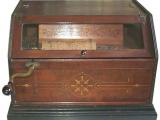A DISCO-val kapcsolatos témakörök, szócikkek készítése, javítása, bővítése és...
music box
zenélõ doboz
Tamás megjegyzései:
Machines capable of controlling the playback of music date back to the middle ages, when pinned barrel mechanisms driven by pre-wound clockwork were used to control pipe organs (and later, harmoniums and the plucked-comb instruments we now think of as "music boxes"). One might dismiss such devices as being outside the realm of �artificially assisted performance,� but I think that�s a mistake: the decision that "now, there will be music" is a musical decision; causing musical sounds to come into existence by force of will is inherently gratifying.
The 1870s saw the introduction of hand-cranked, paper-roll-controlled "organettes." These offered the player control of tempo and, in some cases, volume. The device shown above is a pin-barrel organette.

